
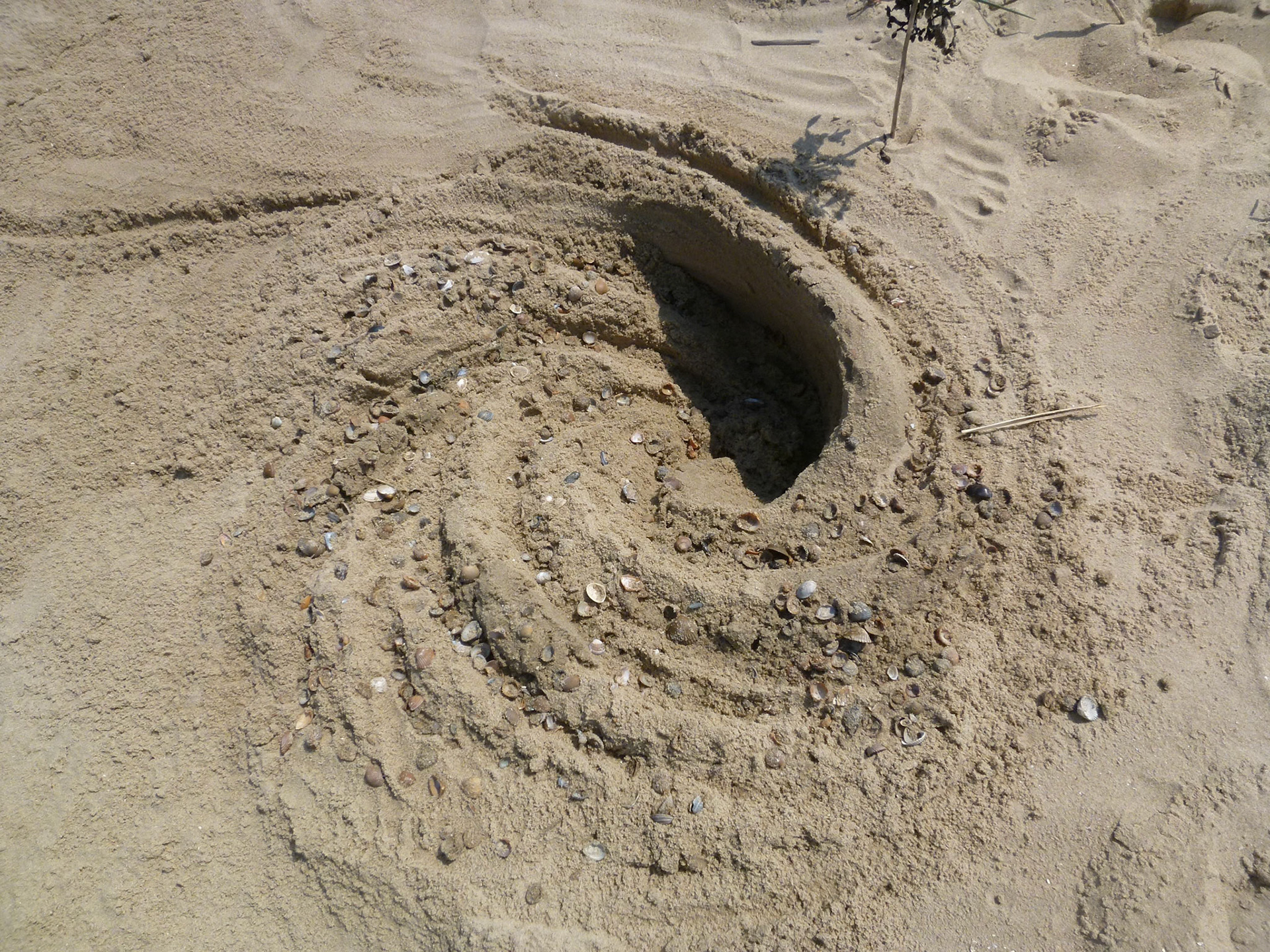
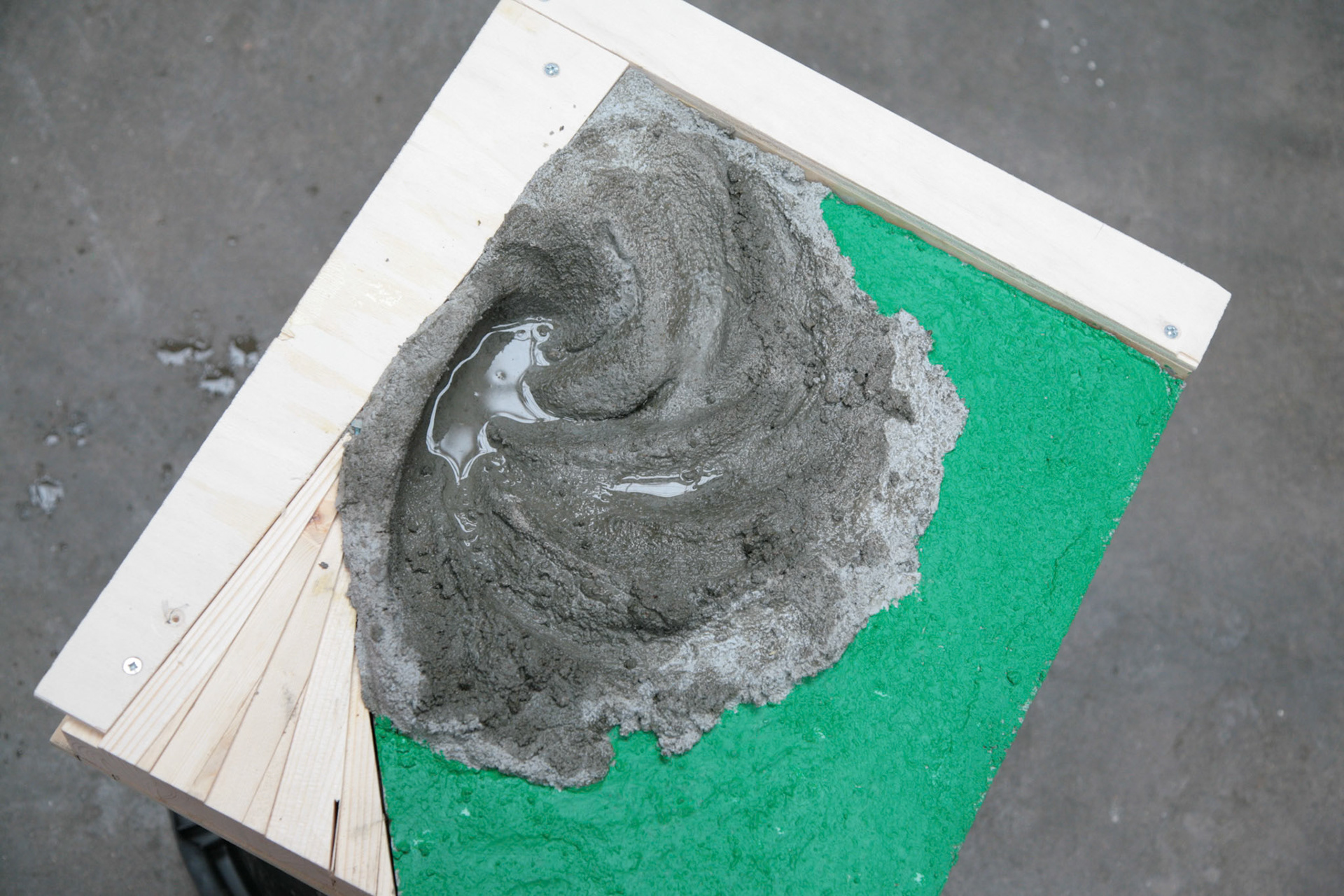
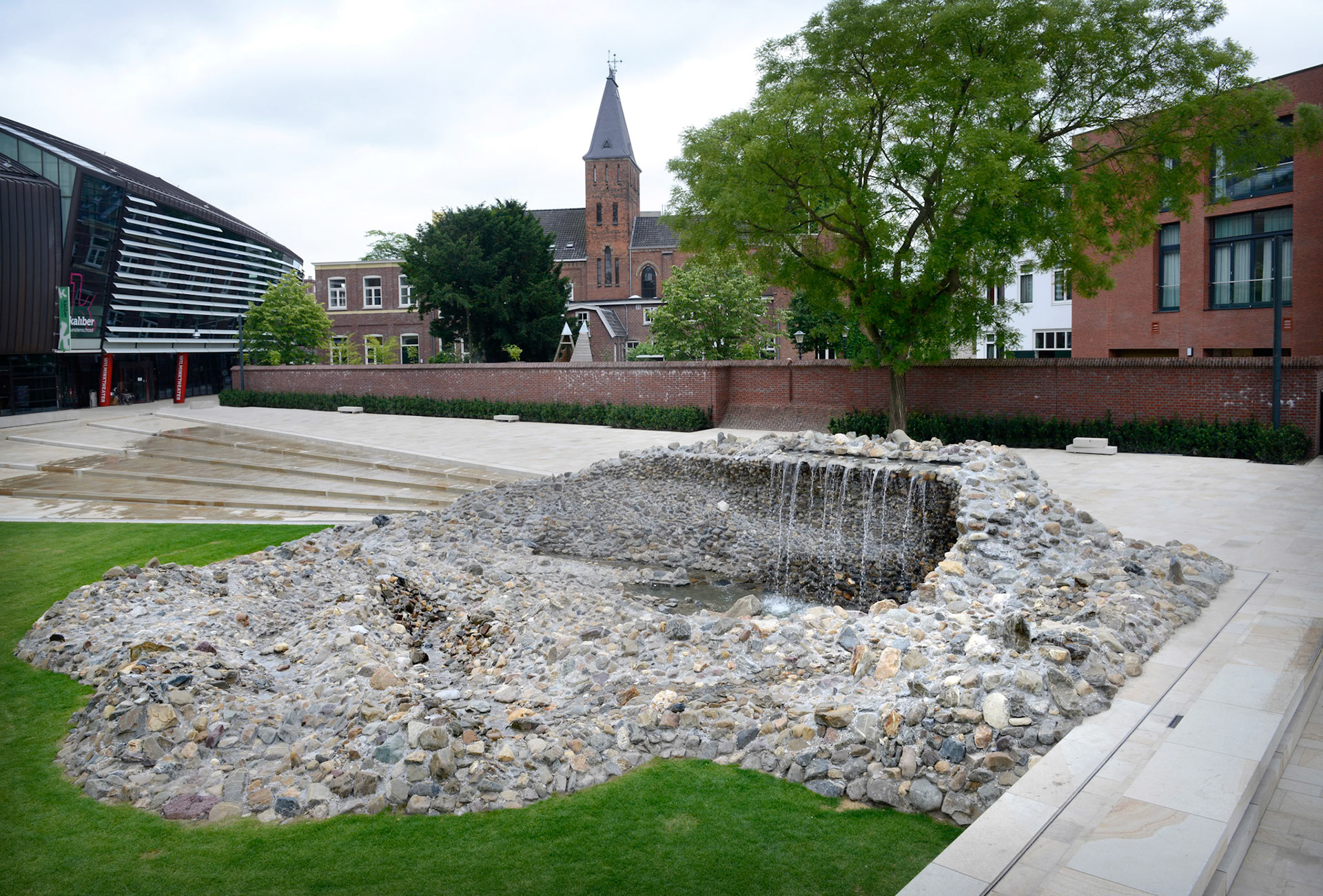
NIEUWE STADSTUIN VOOR ENSCHEDEWoensdag 18 juni zette wethouder Hatenboer de kraan open van het kunstwerk Vortex, onderdeel van het nieuwe Willem Wilminkplein in het centrum van Enschede. Sindsdien stroomt het water over een brede, luie natuurstenen trap richting de Vortex. Het kunstwerk is een uit keien opgebouwde ÔdraaikolkÕ waarin een waterval over een muurtje drie meter omlaag klatert.Kunstenaar Jeroen Doorenweerd ontwierp in nauwe samenwerking met gemeentelijk ontwerper Hans Schršder deze eigentijdse folly als integraal onderdeel van de trap en het plein. Hiermee heeft Enschede een sfeervolle groene huiskamer erbij gekregen.Komende zomermaanden kan het publiek het plein en het kunstwerk testen op hun recreatieve kwaliteiten. Op vrijdag 19 september vindt vervolgens de offici‘le opening van het plein plaats met een feestelijke act als startsein van het Willem Wilminkfestival.Muziekkwartier met Willem WilminkpleinIn het Muziekkwartier van Enschede zijn alle belangrijke muziekpodia- en gezelschappen van de stad te vinden. In het hart ervan ligt het nieuwe driehoekige Willem Wilminkplein. Historische gebouwen zoals een voormalig klooster en een fabrieksschool begrenzen samen met nieuwe gebouwen het plein en verlenen het karakter en intimiteit. Het Wilminktheater (2008) van Ector Hoogstad Architecten vormt met het nog op te leveren hotel van Dick van Gameren ŽŽn lange wand. Aan de overzijde realiseerde Onix architecten dit jaar een appartementencomplex met winkels en horeca.Het plein zal een oase in de stad zijn; slechts toegankelijk voor voetgangers en fietsers. Het grote grasveld, de banken eromheen en de cafŽterrassen nodigen uit om de ruimte als stadstuin te gebruiken. Aanlokkelijk middelpunt aan de oostkant vormt de waaiervormige luie trap waar water overheen stroomt, uitmondend in het kunstwerk Vortex. De trap kan gebruikt worden als podium voor kleinschalige muziekoptredens. Een andere blikvanger aan de westkant van het plein wordt de nog in aanbouw zijn
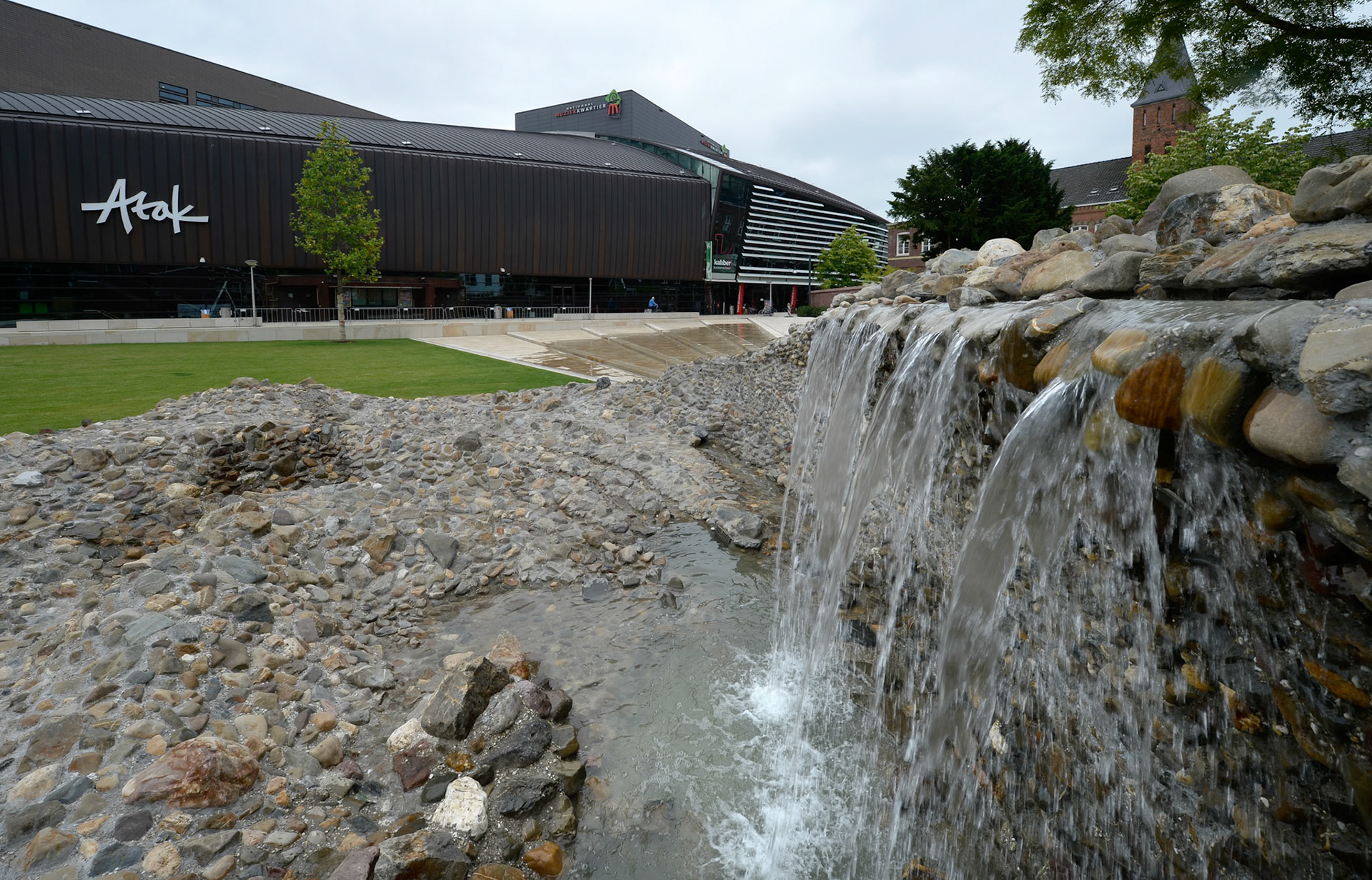
NIEUWE STADSTUIN VOOR ENSCHEDEWoensdag 18 juni zette wethouder Hatenboer de kraan open van het kunstwerk Vortex, onderdeel van het nieuwe Willem Wilminkplein in het centrum van Enschede. Sindsdien stroomt het water over een brede, luie natuurstenen trap richting de Vortex. Het kunstwerk is een uit keien opgebouwde ÔdraaikolkÕ waarin een waterval over een muurtje drie meter omlaag klatert.Kunstenaar Jeroen Doorenweerd ontwierp in nauwe samenwerking met gemeentelijk ontwerper Hans Schršder deze eigentijdse folly als integraal onderdeel van de trap en het plein. Hiermee heeft Enschede een sfeervolle groene huiskamer erbij gekregen.Komende zomermaanden kan het publiek het plein en het kunstwerk testen op hun recreatieve kwaliteiten. Op vrijdag 19 september vindt vervolgens de offici‘le opening van het plein plaats met een feestelijke act als startsein van het Willem Wilminkfestival.Muziekkwartier met Willem WilminkpleinIn het Muziekkwartier van Enschede zijn alle belangrijke muziekpodia- en gezelschappen van de stad te vinden. In het hart ervan ligt het nieuwe driehoekige Willem Wilminkplein. Historische gebouwen zoals een voormalig klooster en een fabrieksschool begrenzen samen met nieuwe gebouwen het plein en verlenen het karakter en intimiteit. Het Wilminktheater (2008) van Ector Hoogstad Architecten vormt met het nog op te leveren hotel van Dick van Gameren ŽŽn lange wand. Aan de overzijde realiseerde Onix architecten dit jaar een appartementencomplex met winkels en horeca.Het plein zal een oase in de stad zijn; slechts toegankelijk voor voetgangers en fietsers. Het grote grasveld, de banken eromheen en de cafŽterrassen nodigen uit om de ruimte als stadstuin te gebruiken. Aanlokkelijk middelpunt aan de oostkant vormt de waaiervormige luie trap waar water overheen stroomt, uitmondend in het kunstwerk Vortex. De trap kan gebruikt worden als podium voor kleinschalige muziekoptredens. Een andere blikvanger aan de westkant van het plein wordt de nog in aanbouw zijnde monumentale buitentrap die toegang zal geven tot de muziekschool in het Wilminktheater en het nieuwe hotel. Ook deze trap kan als podium en verblijfsplek dienen en biedt bovendien uitzicht op het naastgelegen stationsplein.VortexDe vorm van het plein inspireerde kunstenaar Jeroen Doorenweerd (Tilburg) tot zijn kunstwerk. Hij vertelt: ÒHet plein is driehoekig en door de diagonalen krijgt de ruimte dynamiek. De treden van de trap zijn samengeknepen lijnen die op het smalste punt een natuurlijke aanleiding vormen voor een cirkel, waarin de Vortex ligt. Over een wandje klatert water drie meter omlaag als een gecultiveerde waterval. Via stapstenen kun je, als je durft, naar beneden lopen, achter het water langs. De vormgeving met keien is afgeleid van de techniek van de gewassen grindtegel, die in de jaren zeventig grote populariteit genoot.ÓDoorenweerd over de inhoud van zijn werk: ÓVortex betekent eigenlijk werveling, in vloeistof of in lucht, zoals een draaikolk of een tornado. Daarnaast is het ook een term die veel in de Science Fiction wordt gebruikt; Ôto disappear into the vortexÕ wil zeggen dat je in een andere tijd en ruimte terecht komt. Je wordt tegen wil en dank meegenomen naar een andere wereld en daar ligt een parallel met kunst, want kunst behoort dat eigenlijk ook te doen.Ó©foto eric brinkhorst
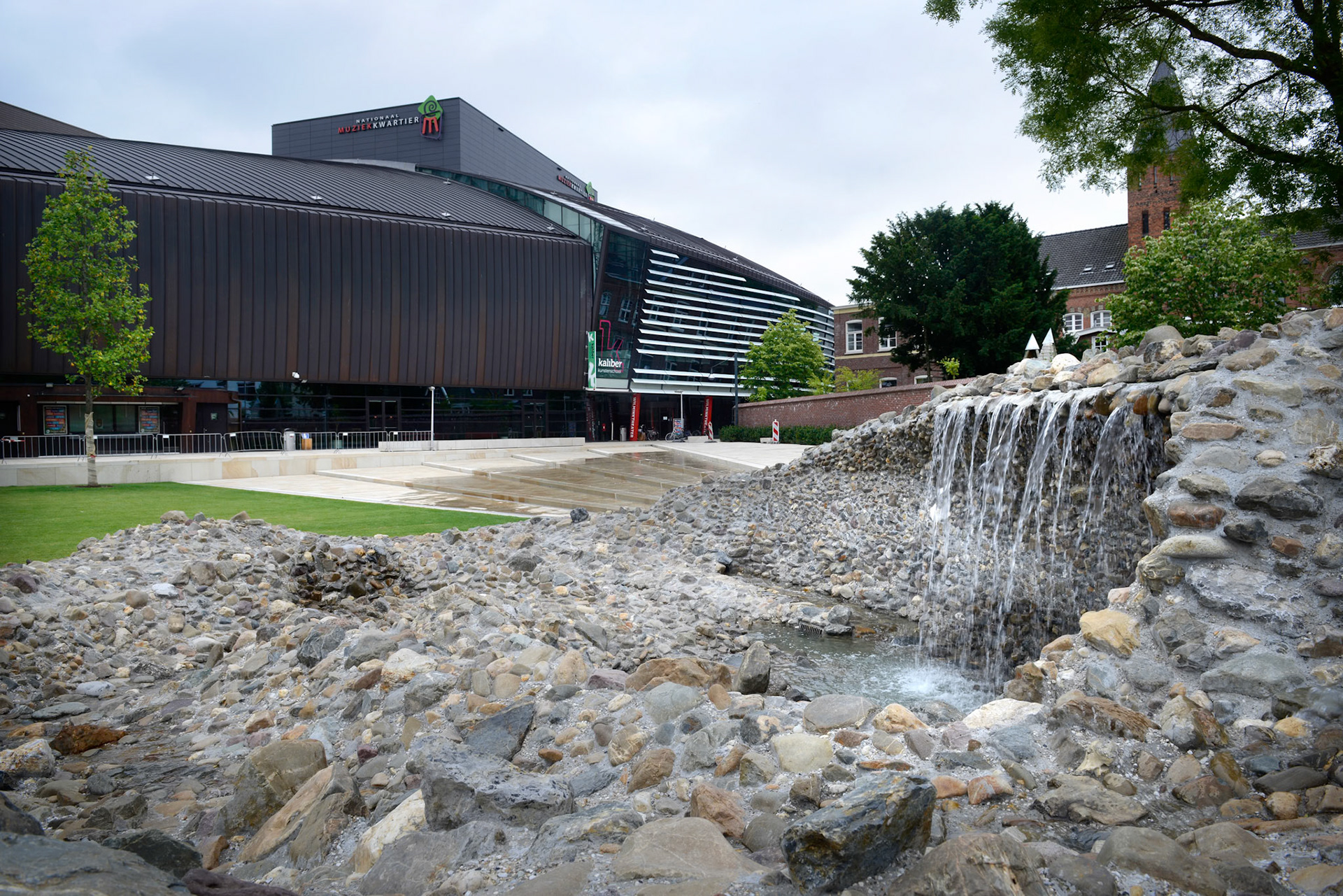
NIEUWE STADSTUIN VOOR ENSCHEDEWoensdag 18 juni zette wethouder Hatenboer de kraan open van het kunstwerk Vortex, onderdeel van het nieuwe Willem Wilminkplein in het centrum van Enschede. Sindsdien stroomt het water over een brede, luie natuurstenen trap richting de Vortex. Het kunstwerk is een uit keien opgebouwde ÔdraaikolkÕ waarin een waterval over een muurtje drie meter omlaag klatert.Kunstenaar Jeroen Doorenweerd ontwierp in nauwe samenwerking met gemeentelijk ontwerper Hans Schršder deze eigentijdse folly als integraal onderdeel van de trap en het plein. Hiermee heeft Enschede een sfeervolle groene huiskamer erbij gekregen.Komende zomermaanden kan het publiek het plein en het kunstwerk testen op hun recreatieve kwaliteiten. Op vrijdag 19 september vindt vervolgens de offici‘le opening van het plein plaats met een feestelijke act als startsein van het Willem Wilminkfestival.Muziekkwartier met Willem WilminkpleinIn het Muziekkwartier van Enschede zijn alle belangrijke muziekpodia- en gezelschappen van de stad te vinden. In het hart ervan ligt het nieuwe driehoekige Willem Wilminkplein. Historische gebouwen zoals een voormalig klooster en een fabrieksschool begrenzen samen met nieuwe gebouwen het plein en verlenen het karakter en intimiteit. Het Wilminktheater (2008) van Ector Hoogstad Architecten vormt met het nog op te leveren hotel van Dick van Gameren ŽŽn lange wand. Aan de overzijde realiseerde Onix architecten dit jaar een appartementencomplex met winkels en horeca.Het plein zal een oase in de stad zijn; slechts toegankelijk voor voetgangers en fietsers. Het grote grasveld, de banken eromheen en de cafŽterrassen nodigen uit om de ruimte als stadstuin te gebruiken. Aanlokkelijk middelpunt aan de oostkant vormt de waaiervormige luie trap waar water overheen stroomt, uitmondend in het kunstwerk Vortex. De trap kan gebruikt worden als podium voor kleinschalige muziekoptredens. Een andere blikvanger aan de westkant van het plein wordt de nog in aanbouw zijn
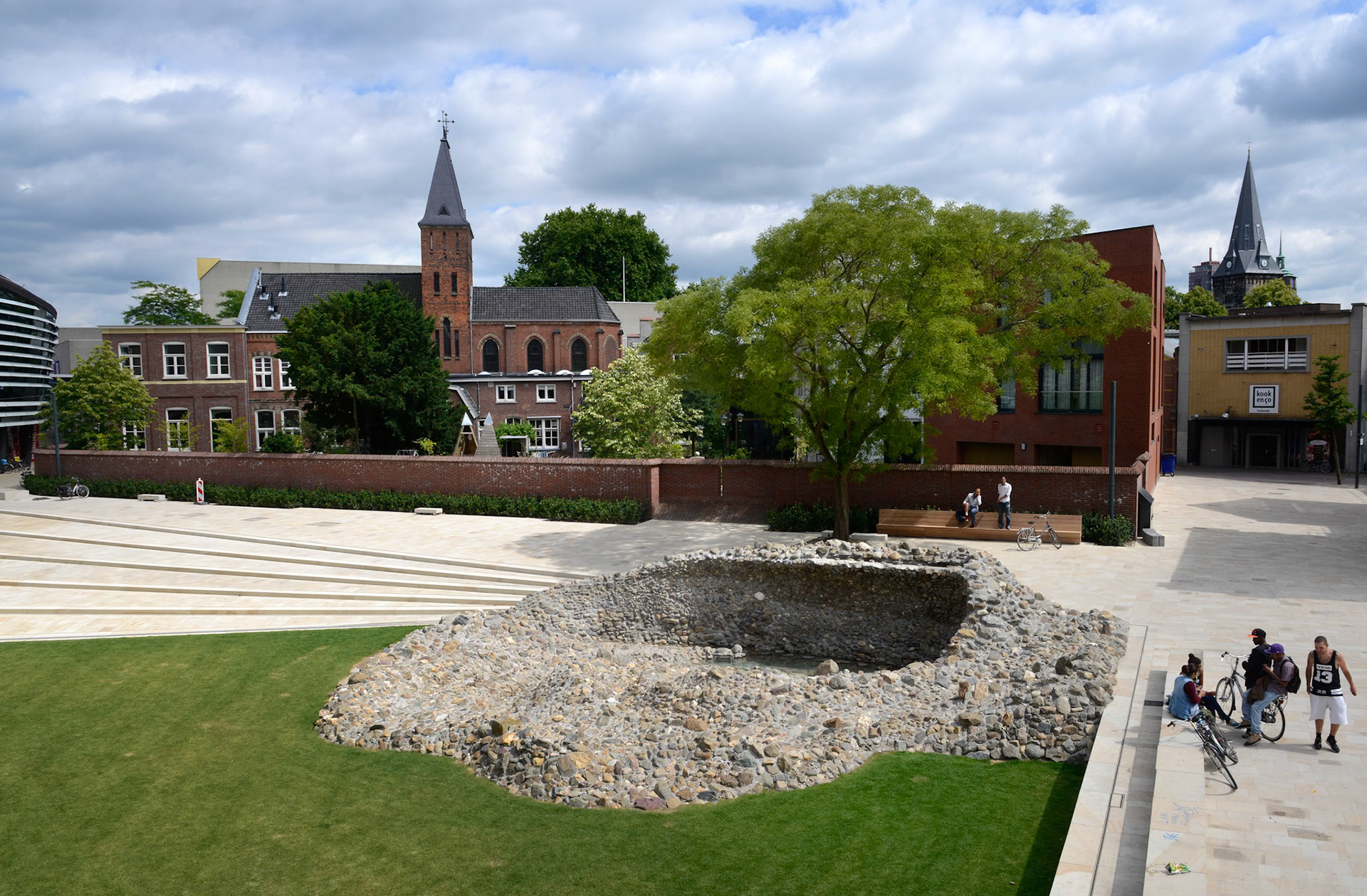
NIEUWE STADSTUIN VOOR ENSCHEDEWoensdag 18 juni zette wethouder Hatenboer de kraan open van het kunstwerk Vortex, onderdeel van het nieuwe Willem Wilminkplein in het centrum van Enschede. Sindsdien stroomt het water over een brede, luie natuurstenen trap richting de Vortex. Het kunstwerk is een uit keien opgebouwde ÔdraaikolkÕ waarin een waterval over een muurtje drie meter omlaag klatert.Kunstenaar Jeroen Doorenweerd ontwierp in nauwe samenwerking met gemeentelijk ontwerper Hans Schršder deze eigentijdse folly als integraal onderdeel van de trap en het plein. Hiermee heeft Enschede een sfeervolle groene huiskamer erbij gekregen.Komende zomermaanden kan het publiek het plein en het kunstwerk testen op hun recreatieve kwaliteiten. Op vrijdag 19 september vindt vervolgens de offici‘le opening van het plein plaats met een feestelijke act als startsein van het Willem Wilminkfestival.Muziekkwartier met Willem WilminkpleinIn het Muziekkwartier van Enschede zijn alle belangrijke muziekpodia- en gezelschappen van de stad te vinden. In het hart ervan ligt het nieuwe driehoekige Willem Wilminkplein. Historische gebouwen zoals een voormalig klooster en een fabrieksschool begrenzen samen met nieuwe gebouwen het plein en verlenen het karakter en intimiteit. Het Wilminktheater (2008) van Ector Hoogstad Architecten vormt met het nog op te leveren hotel van Dick van Gameren ŽŽn lange wand. Aan de overzijde realiseerde Onix architecten dit jaar een appartementencomplex met winkels en horeca.Het plein zal een oase in de stad zijn; slechts toegankelijk voor voetgangers en fietsers. Het grote grasveld, de banken eromheen en de cafŽterrassen nodigen uit om de ruimte als stadstuin te gebruiken. Aanlokkelijk middelpunt aan de oostkant vormt de waaiervormige luie trap waar water overheen stroomt, uitmondend in het kunstwerk Vortex. De trap kan gebruikt worden als podium voor kleinschalige muziekoptredens. Een andere blikvanger aan de westkant van het plein wordt de nog in aanbouw zijnde monumentale buitentrap die toegang zal geven tot de muziekschool in het Wilminktheater en het nieuwe hotel. Ook deze trap kan als podium en verblijfsplek dienen en biedt bovendien uitzicht op het naastgelegen stationsplein.VortexDe vorm van het plein inspireerde kunstenaar Jeroen Doorenweerd (Tilburg) tot zijn kunstwerk. Hij vertelt: ÒHet plein is driehoekig en door de diagonalen krijgt de ruimte dynamiek. De treden van de trap zijn samengeknepen lijnen die op het smalste punt een natuurlijke aanleiding vormen voor een cirkel, waarin de Vortex ligt. Over een wandje klatert water drie meter omlaag als een gecultiveerde waterval. Via stapstenen kun je, als je durft, naar beneden lopen, achter het water langs. De vormgeving met keien is afgeleid van de techniek van de gewassen grindtegel, die in de jaren zeventig grote populariteit genoot.ÓDoorenweerd over de inhoud van zijn werk: ÓVortex betekent eigenlijk werveling, in vloeistof of in lucht, zoals een draaikolk of een tornado. Daarnaast is het ook een term die veel in de Science Fiction wordt gebruikt; Ôto disappear into the vortexÕ wil zeggen dat je in een andere tijd en ruimte terecht komt. Je wordt tegen wil en dank meegenomen naar een andere wereld en daar ligt een parallel met kunst, want kunst behoort dat eigenlijk ook te doen.Ó©foto eric brinkhorst

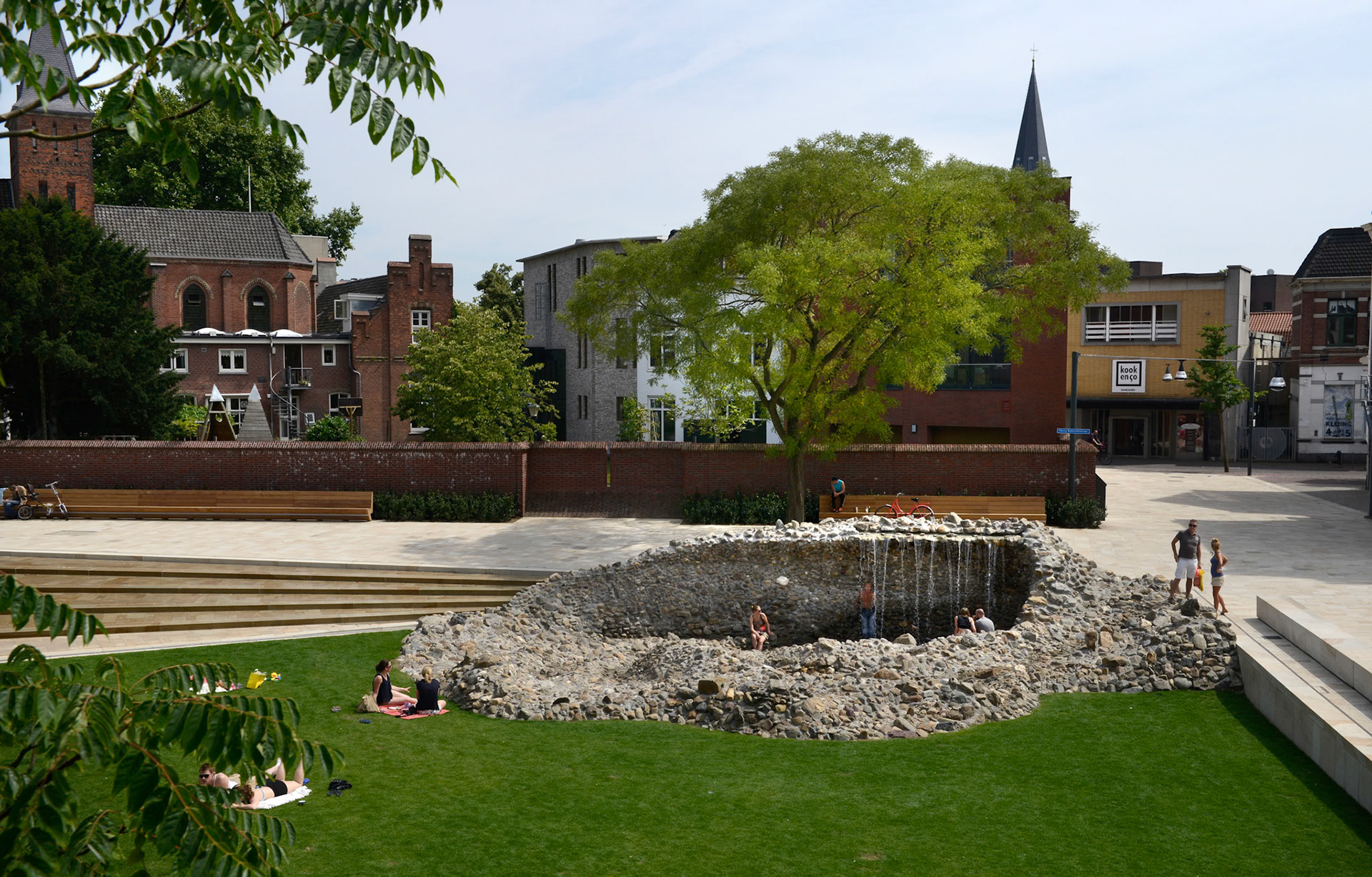
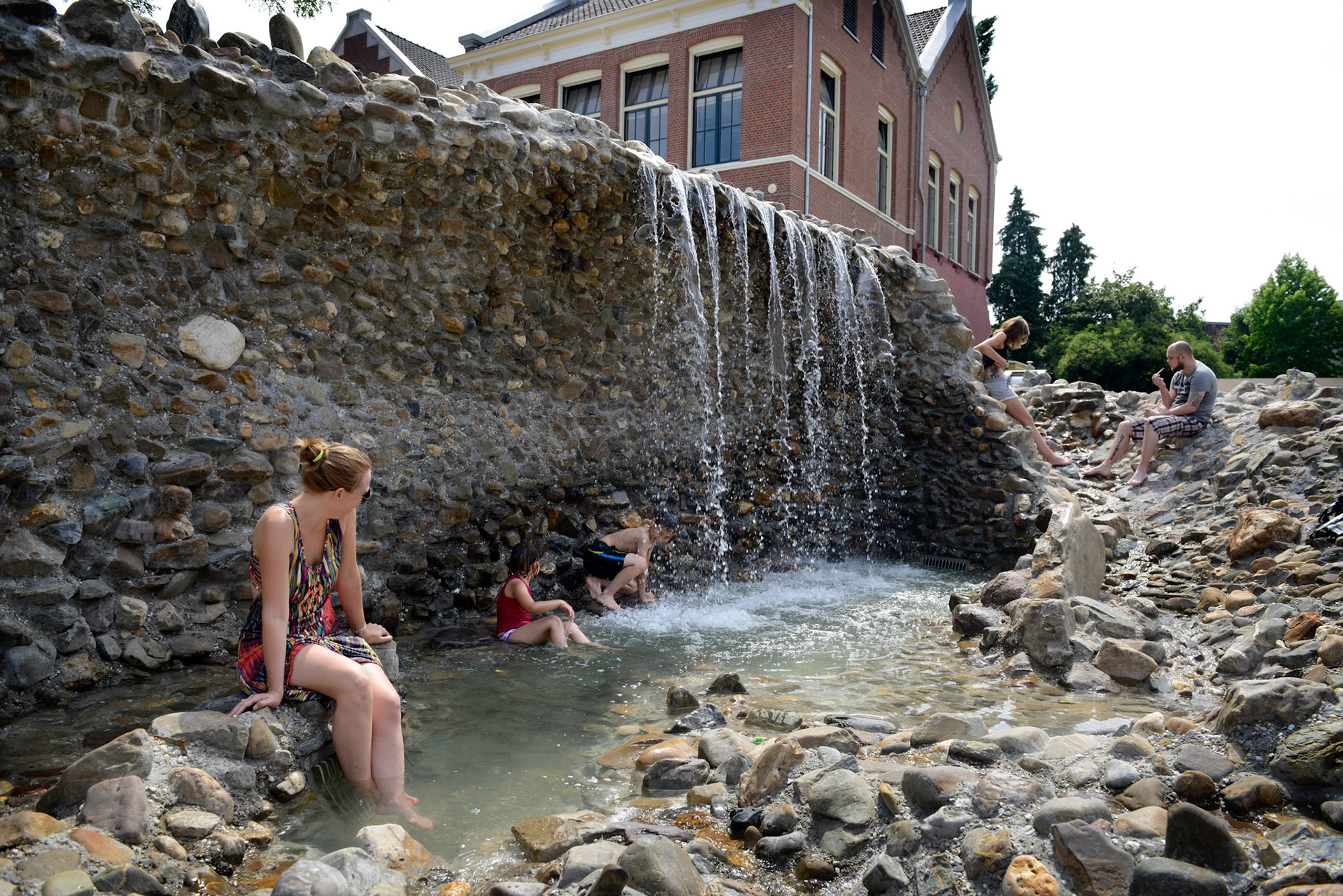

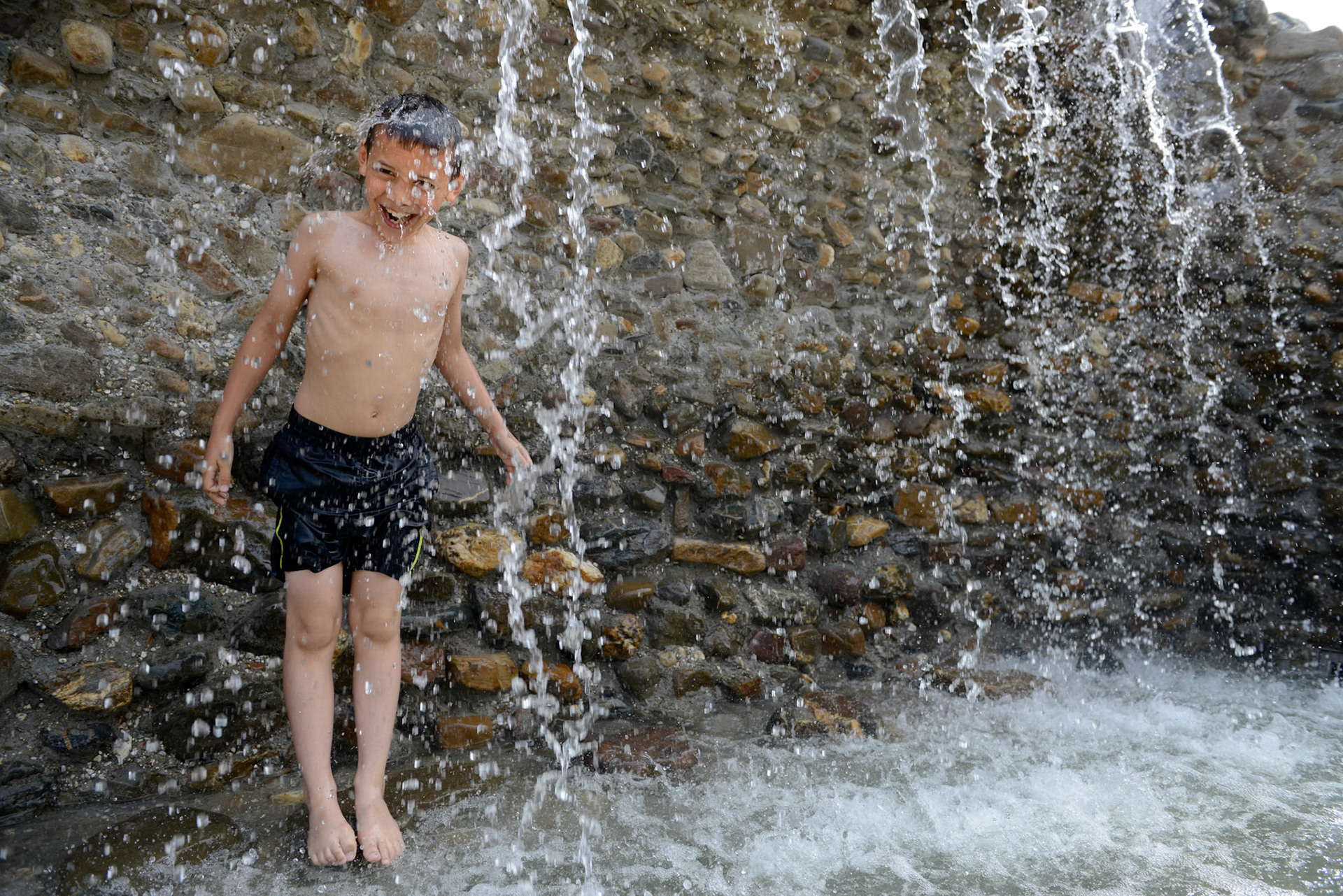

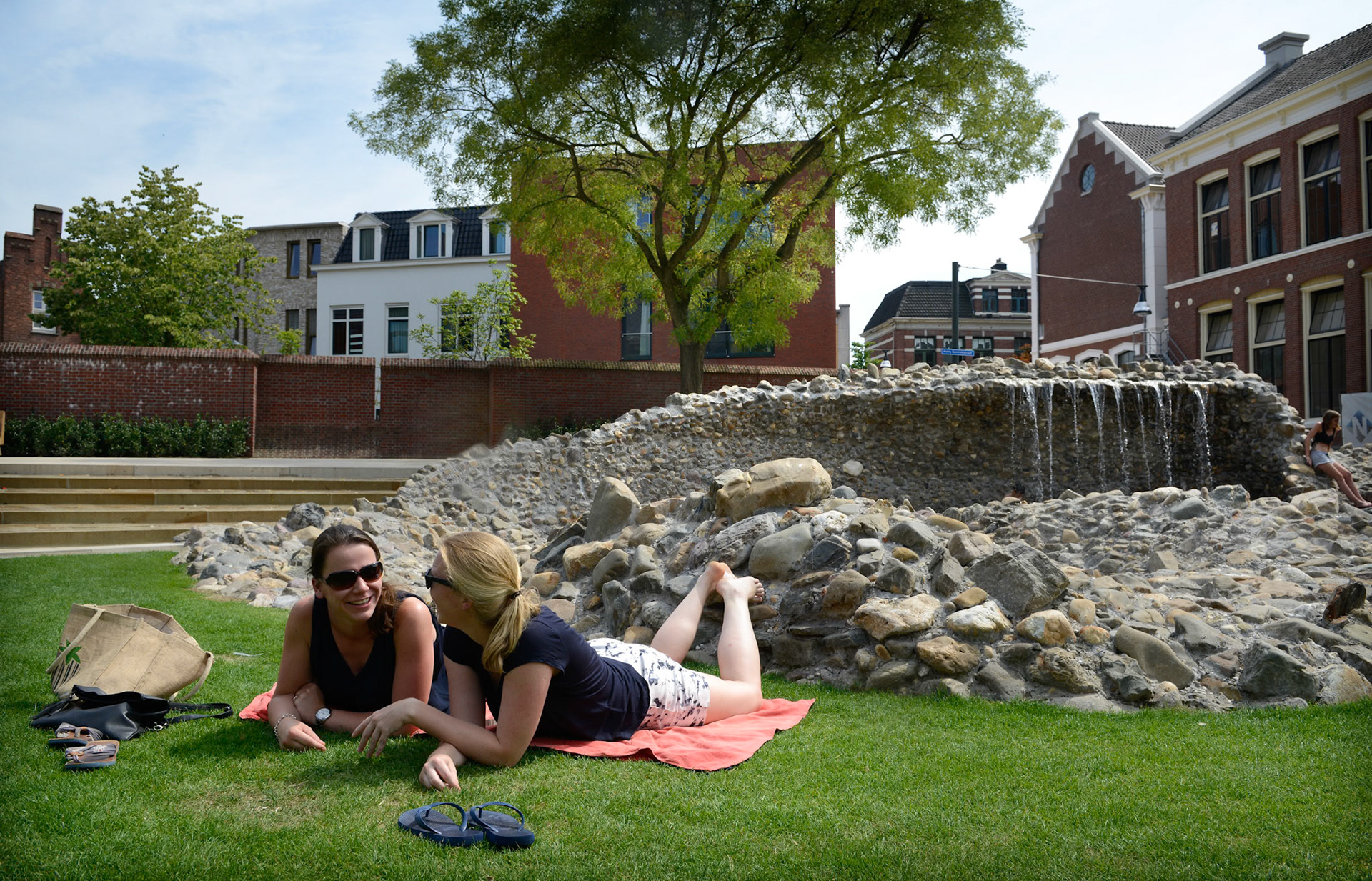


Commissioned by the city of Enschede, in coöperation with Hans Schröder
photo's Eric Brinkhorst
VORTEX
When you come out of the station at Enschede you enter the kind of station square of which there are so many in the Netherlands. A place for buses and traffic, signs pointing to the left, to the museum and to the right for the city centre. But if you choose to ignore the signs and continue a little way on, alongside the railway line, you will find yourself in a very different spot. You are now in the Willem Wilminkplein, completed in 2014. It is a large, somewhat enclosed square, surrounded by apartment buildings with cafés, restaurants and facilities for a music centre at ground level. And there, in the middle of the square, is a stretch of grass with, right at the back, a corner which seems to belong to another age. It is a cave with waterfall and a pool, a tiny piece of robust Nature that seems out of place in the surrounding functionality.
Yet it is of the same recent construction as the rest of the square, a work of art by Jeroen Doorenweerd who designed it specifically for this location. “Vortex” is its name and, if you were unaware of this technological and futuristic title, you might see it as a small oasis of romanticism. It looks a lot like a grotto, a folly, a completely useless little structure, something entirely whimsical that seems to have come from someone’s imagination. So it is in stark contrast to its smooth brick surroundings. Is it a dream, a fairy tale, the point of impact of a meteorite, the molehill of a monster you would not wish to meet? Because Vortex defies all functional definitions it gives this new square a spot where there are no rules or expectations, you are not expected to do anything there. You can simply sit down, doing nothing, allowing your imagination to run free just as the artist did here.
Yet it is of the same recent construction as the rest of the square, a work of art by Jeroen Doorenweerd who designed it specifically for this location. “Vortex” is its name and, if you were unaware of this technological and futuristic title, you might see it as a small oasis of romanticism. It looks a lot like a grotto, a folly, a completely useless little structure, something entirely whimsical that seems to have come from someone’s imagination. So it is in stark contrast to its smooth brick surroundings. Is it a dream, a fairy tale, the point of impact of a meteorite, the molehill of a monster you would not wish to meet? Because Vortex defies all functional definitions it gives this new square a spot where there are no rules or expectations, you are not expected to do anything there. You can simply sit down, doing nothing, allowing your imagination to run free just as the artist did here.
This uselessness is something it has in common with the follies which became popular in 18th-century English landscape gardens. Tiny structures scattered throughout the greenery were expressions of the ideal of beauty in picturesque Nature. “Picturesque” was the name of the aesthetic longing that inspired people to model landscapes on paintings, instead of the other way round. So these landscape gardens were designed to display a great variety of styles, with rolling hills interspersed with relatively useless little buildings, to fill in the view in between them. The classical “tempietto” was one of the most straightforward variants while the darker Romanticism inspired more fanciful versions such as ruins and grottos. This fanciful quality is to be found in Enschede, as if it has been teleported from a completely different time and place. Doorenweerd even seems to have adopted the two-dimensional view of Nature as painted by an artist: Vortex presents a frontal view, as if life were a visual décor to behold.
Art as the outsider, or odd man out, is a recurring theme in Doorenweerd’s work. As a spatial artist he designs works of art which derive their meaning from the location for which they were created. He uses locations as a setting about which he tells a story, using a visual relationship into which he introduces a certain tension. This can be said, for example, of his “Dragon” in a new housing estate in Hoorn, which is just as neat and well-ordered as the Willem Wilmink Square, as state that he broke through by placing a yacht there on a improbably slim, high pedestal. The boat does not belong there and certainly not in such a way that it juts out so high above ground level. In this way he creates tension with a story line – what is it doing here, where do these things come from?
Tension was even more evident in Doorenweerd’s well known, perhaps even infamous, swimming pool in the Vught penitentiary. Art in prisons often has a socially friendly function but this work was an exception to the rule: prisoners were not allowed to swim in it. It was Art. In this respect the inhabitants of Enschede are more fortunate; their pool is accessible and was immediately put to use in the warm summer of 2014 by those seeking to cool off in its water. Again, in the work of art, Doorenweerd makes contrast an essential part of it: the whimsical natural grotto with its baroque-Romantic aesthetic does not belong in a city, nor in the Dutch landscape and not at all in a newly-built square.
But Vortex is not just looking back to bygone times. As the title suggests, it is also inspired by a physical force that is a favourite theme in science fiction. A vortex is a whirlpool that sucks its surroundings in towards it. Doorenweerd worked on this together with city planner Hans Schröder, to develop the entire square: grass and steps were drawn into the plan as part of the work of art. With their slanting lines they move in the direction of the grotto, which, as heart of the square, appears to be setting them in motion and sucking them up.
Vortexes are related to the whirlpools in water and to tornados in the air. But in visual culture they are mainly known from sci-fi films, set in far-away star systems. There they suck in the material in black holes or spit out heroes into parallel universes. Everything they do is done in a violent or liberating way, as if they are a gateway to the unknown. Extraterrestrial actions like this are just as out of place in an intimately walled city square as an 18th century grotto folly. In the work of art this type of completely contrasting associations becomes a metaphor for imagination, for allowing yourself to fantasize that you are somewhere else This is what art can do. And so, in this way, Doorenwerd brings together various visual cultures: space travel and teleportation from futuristic sci-fi films together with the escapism of pre-industrial Romanticism. All this drama he has fused together in his Vortex. And …. it seemed to be such a friendly little square.
Sandra Smets